back to
The 1901 Pan-American Stamps
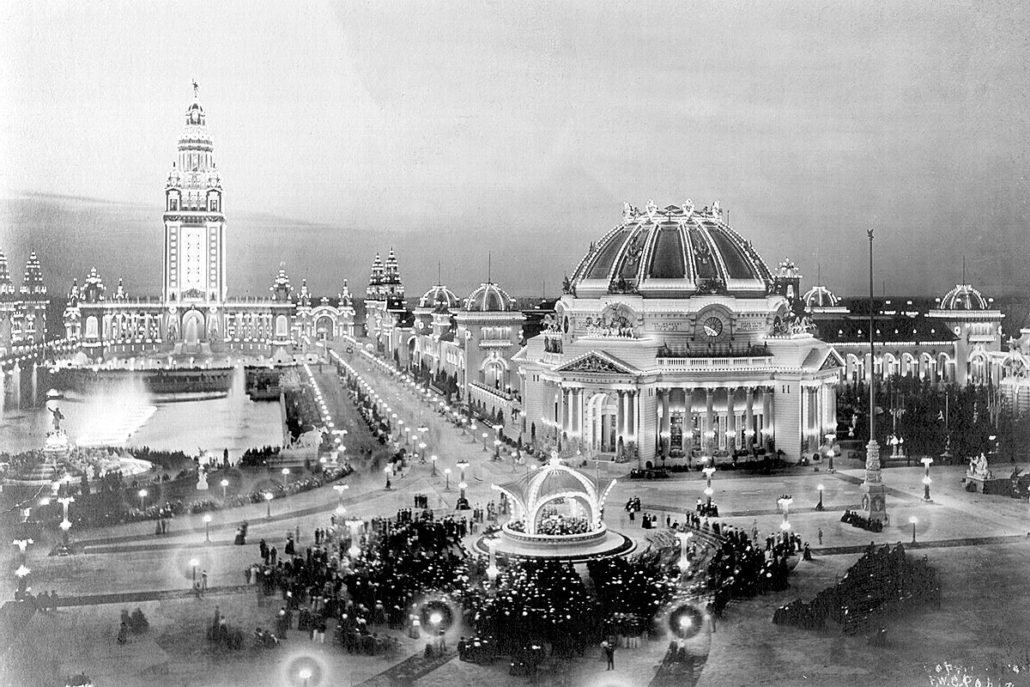
The first U.S. stamps of the 20th century, the Pan-American series was issued to publicize the Pan-American Exposition in Buffalo, New York, held from May 1 to November 2, 1901.
The exposition was a tremendous success, with its goal to promote "commercial well-being and good understanding among the American republics". Originally conceived to be held in 1899 near Niagara Falls, its location was changed to Buffalo to be more accessible and accommodate larger crowds, and the Spanish-American War delayed its opening until 1901. The 350-acre fairgrounds featured more than a dozen specially constructed buildings, and the buildings and grounds were illuminated by electric light, using the recently invented alternating current system that allowed electricity generated 25 miles away at Niagara Falls to light the fair. The exposition is also notable for one unfortunate event: on September 6, 1901, President William McKinley was shot while greeting crowds inside the Temple of Music and he died eight days later from infections of the gunshot wounds.
In 1899 the Pan American Exposition promoters petitioned the U.S. Post Office for a set of commemorative stamps to be issued to commemorate the event. The philatelic community was wary of the idea, having felt burned by the expensive Columbian and Trans-Mississippi sets. The Post Office responded to their protests by announcing that they would issue just six stamps ranging in face value from 1 to 10 cents. At a total of 30 cents, versus $16.34 for the Columbian issue and $3.80 for the Trans-Mississippi issue, collectors were happy and they were a hit with the public. Others felt that since some of the stamps pictured identifiable vehicles and vessels owned by private companies, the stamps could be seen as advertisements for those companies.
The first American stamps of the 20th century, the series featured images capturing new ideas and concepts for a new century – the latest advances in transportation including modern steamships, an electric automobile, a fast locomotive, a man-made canal, and a modern steel bridge. Keeping with the theme of technological advancements, the series would be printed in two colors – the first for United States commemoratives and the first time since 1869 that any American stamp would be printed in two colors. However, to print two colors it meant that each sheet of stamps required two passes through the printing press, which resulted in the occasional mistake such as a misplaced center image, and inverted centers were discovered on the 1, 2 and 4 cent stamps. These inverted centers are among the scarcest and most desirable U.S. stamps, with only a few hundred of each discovered. Actually the frames are inverted since the centers were printed first!
Sources of the Designs
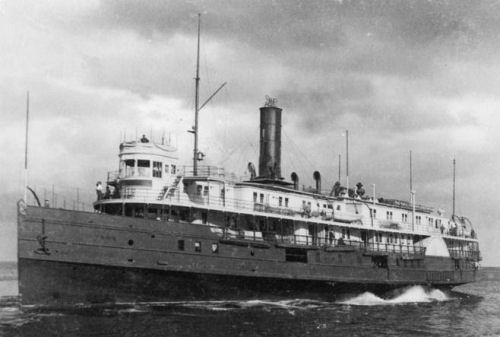 |
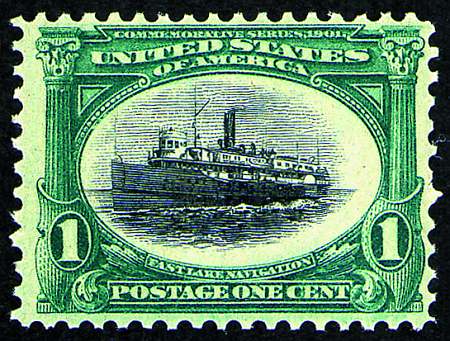 |
|
1¢ "Fast Lake Navigation" (Scott #294) The one cent stamp depicts the "City of Alpena", a 1282-ton sidewheel steamer that navigated the Great Lakes between Detroit and Mackinac Island. It was owned and operated by the Detroit and Cleveland Steam Navigation Company from 1893 to 1921, and carried up to 400 passengers as well as commercial freight. It later went through several owners and was scrapped in 1957. Soon after the stamp's release, a sheet was sold to the Carrell Jewelry Company in Bessemer, Alabama, and after several had been used on company mail it was discovered that the centers were inverted. Additional invert sheets were discovered in New York, Connecticut and Virginia, and were soon being sold for $25 a stamp. Today this invert has a catalog value of $12,500. |
|
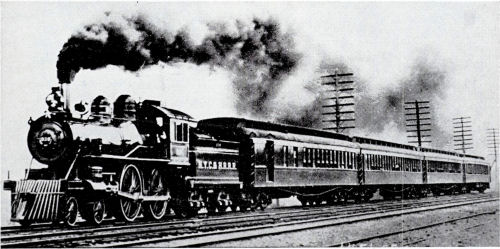 |
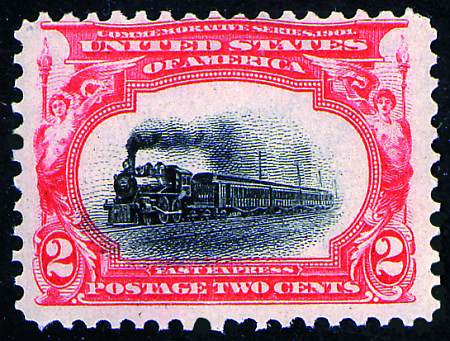 |
|
2¢ "Locomotive Express" (Scott #295) The two cent stamp pictures the "Empire State Express", pulled by a locomotive known as "Locomotive 938", built in 1898 and operated by the New York Central and Hudson River Railroad. A different locomotive, known as "Locomotive 999" is often miscredited as the source for this stamp. In 1893 Locomotive 999 was the fastest long-distance locomotive in the world, setting a speed record for a land vehicle of 112.5 miles per hour. Locomotive 999 is now on display at the Museum of Science and Industry in Chicago. As with the one cent stamp, this stamp can be found with inverted centers. However, this invert is much scarcer and has a catalog value of $50,000. |
|
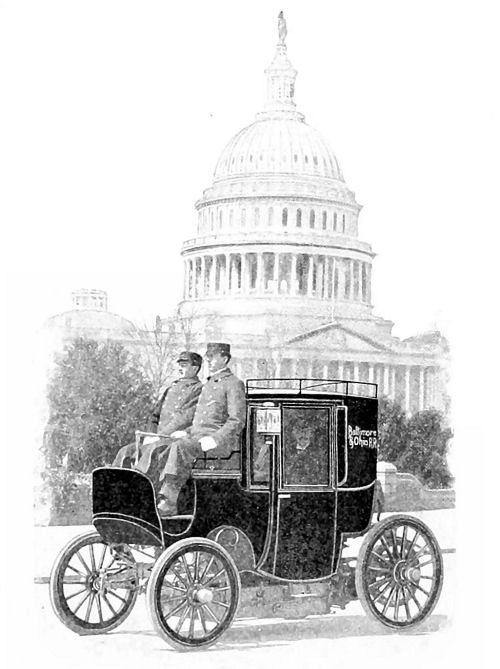 |
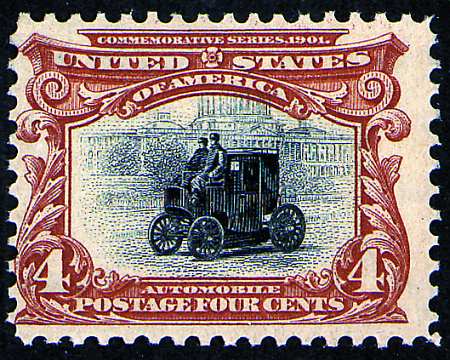 |
|
4¢ "Automobile" (Scott #296) The four cent stamp shows a Columbia electric hansom cab operated by the Baltimore and Ohio Railroad, and illustrated in the September 1900 issue of the B&O monthly "Book of the Royal Blue Line". The service was established in Washington, D.C., on May 1, 1900, in conjunction with the Washington Electric Vehicle Transportation Company to shuttle passengers from the B&O stations to points throughout the city. The passenger barely visible inside the cab is said to be Samuel Bitner Hege, the passenger representative for B&O. This was the first stamp in the world to picture an automobile! While the four cent stamp exists with inverted centers, unlike the one and two cent inverts which were unintentional printing errors, the four cent invert was a deliberate special printing ordered by the Third Assistant Postmaster General, Edwin C. Madden. When the one and two cent inverts were discovered, Madden ordered the Bureau of Engraving and Printing to hand over any invert sheets they had. Having no invert sheets on hand, and misunderstanding Madden's orders, the Bureau printed four sheets of 100 of the four cent stamp and handed them over. About half were overprinted "specimen". For a few years, Madden would hand out inverts to friends and dignitaries, and he kept detailed notes of every stamp he handed out, most with the "specimen" overprint. Later, a full sheet was donated to the national stamp collection in the Smithsonian. In 1914, Joseph B. Leavy, taking advantage of a rule that allowed him to swap duplicate stamps in the museum's collections for items it needed, broke up the sheet and swapped many of the inverts with prominent stamp dealers for material the museum needed, including inverts from the 1869 series. Despite the controversy and the unconventional method of distribution, the four cent invert is one of the nation's great stamp rarities and has a catalog value today of $85,000. |
|
 |
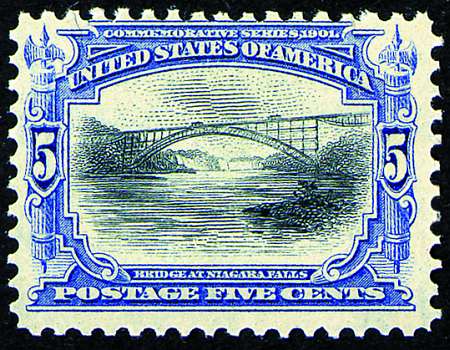 |
|
5¢ "Bridge at Niagara Falls" (Scott #297) The five cent stamp shows the Upper Steel Arch Bridge, also known as the Honeymoon Bridge, which crossed the Niagara River just below Niagara Falls. When it was completed in 1898 it was the largest steel arch bridge in the world. It included a double track for trolleys and room for carriages and pedestrians. Because the Niagara River freezes most winters, the bridge had to be constantly protected from ice dams. In 1938 a fierce wind storm sent a massive amount of ice over the falls, causing the bridge to collapse. Its replacement, the Rainbow Bridge, opened in 1941. |
|
 |
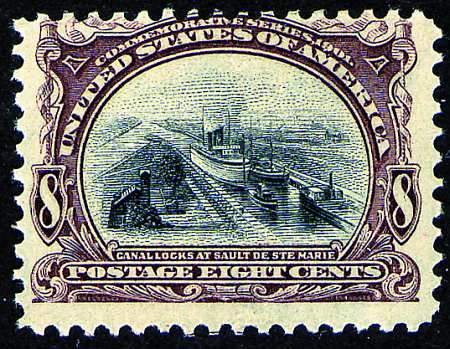 |
|
8¢ "Canal at Sault de Ste. Marie" (Scott #298) The eight cent stamp shows the Sault Sainte Marie Canal Locks, also known as the Soo Locks, on the St. Marys River in Sault Ste. Marie, Ontario, between Lakes Superior and Huron. Completed in 1895, it was the largest lock in the world and the first electric lock. The lock was shut down in 1987, and it is now a historic site and part of the Canadian national park system. |
|
 |
 |
|
10¢ "Fast Ocean Navigation" (Scott #299) The ten cent stamp pictures the S.S. St. Paul, an oceangoing steamship owned by the American Line (later the International Navigation Company), which was launched in 1895. It was able to cross the Atlantic in ten days, one of the fastest ocean liners of its day. The St. Paul was the first ship taken over by the U.S. government for the Spanish-American War as an auxiliary cruiser. It returned to commercial service after the war, but was again recruited for service in World War I as a transport. After 28 years of service the St. Paul was sold for scrap in 1923. |
|
The 2001 Reissue of the Inverts
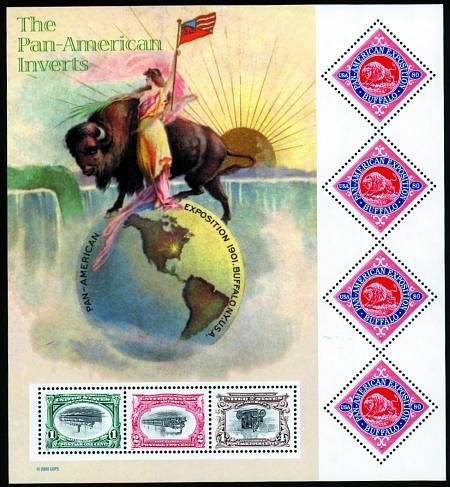
On March 29, 2001, the U.S. Post Office marked the 100th anniversary of the Pan-American series with a special sheet reproducing the three inverts, using images taken from the original engraved steel dies. The sheet also included four 80-cent stamps reproducing an original publicity label printed for the 1901 Exposition. (Scott #3505)

